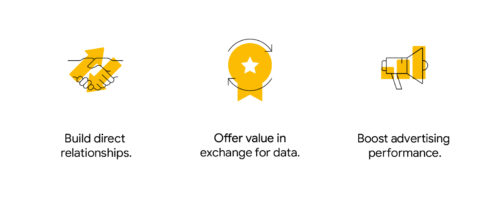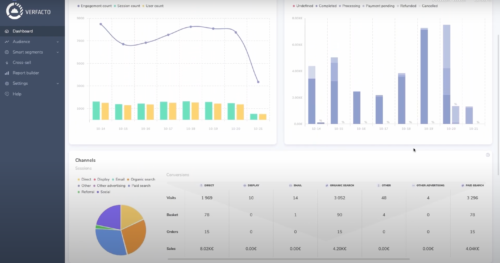First-party data is the information a business collects from their customers while they are using the company’s website, apps, or email marketing.
This information is not actively provided by the user – as it is in zero-party data – but given passively while the customer is browsing through the website. The data collected might include things like how long the user spends on a page, which links they click, which products they visit, etc.
The more customer data you have, the better. The information you gather either through zero, first, second or third-party processes is extremely important because it all helps you target the right people and promote your products to them at the right time.
Data-driven marketing, which is based on actual data from real customers, and this specific data, can lead to higher profit, more effective marketing, lower acquisition costs, longer customer lifetime value, and so much more.
But, in order to get all of these benefits, you should first understand what this type of data is, how you can collect it (while respecting data privacy regulations), and how you can use it to improve customer experience and increase your profits.
What Does First-Party Data Mean?
First-party data means that the data collected is provided passively by customers while they are browsing your website, app, or emails. You can get a lot of information from the way a user interacts with your website. For example, their clicks, the amount of time they spend on certain pages, and their purchase history are all extremely valuable data.
In addition to data collected through websites, apps, and emails, you can also get it from SMS, CRM, call centers, and more.
Most importantly, this kind of data complies with eCommerce GDPR and other privacy acts since you are collecting data directly from the source, in this case, a visitor, prospect, or customer.
Why is It Important?

First-party data, just like zero-party data, is highly relevant because it’s information the company possesses by interacting with the user directly. This gives the business autonomy because they’re not dependent on other businesses to provide the data (as with second or third-party data).
Apart from that, here are a few more reasons why it is essential:
The information is very accurate and high-quality as it is provided by the customer himself.
Mapping the customer journey becomes easier, as you can track each customer’s identity and steps through conversion.
With a solid customer journey, your business can be more assertive and deliver the right message at the right time for the right people.
These customer insights help you allocate your budget better and get the most out of your marketing efforts.
It helps you easily create audience segments that improve your communication with customers.
It allows your brand to create customized experiences based on information like location, purchase history, interests, and more.
Lastly, this kind of data is crucial to your business success because it provides great insights about your customers, making the information very accurate and trustworthy. Meanwhile, it also answers some important questions like:
What makes your customers spend more?
What products perform better for upselling and cross-selling?
How can you improve retention and customer loyalty?
Do discounts really work, or do they only cut your potential profits?
How to Collect It?
First-party data can be collected online (websites, apps, email) or offline (in-store, call center). To collect it online, you need to enable specific cookies or a pixel on your website. There are many tools that can help you do this with ease.
Once you gather your data, you must then manage and analyze it. The data isn’t worth much if you can’t access it with ease and then pull information from it that matters for your business.
One of the main ways to use this data is to understand your prospects and customers better, but there are many other things you will want to use it for, and that means it has to be easily accessible and readable.

How to Use First-Party Data for ECommerce
There are several ways you can use first-party data to increase customer engagement, retention, purchase frequency, loyalty, and lifetime. Here are a few ideas to boost your eCommerce success with this information:
Start a loyalty program and provide special discounts, redeemable points, or gifts (learn how to measure customer loyalty here).
Create personalized ads offering different products for different segments of your audience.
Remind your customers of in-store sales based on their location.
Offer a gift or special discount for new customers.
Push existing customers to execute an action when you determine they are ready.
Showcase specific products to specific site visitors based on their interactions with your website and their purchase intentions.
Use the customer’s journey to help you turn leads into actual customers.
Gather information across channels to connect data and provide a better experience to your customer.
We’ve also written comprehensive articles about zero, second and third-party data that might be useful to help you understand how they work. So if you want to keep learning about the subject, go ahead and check them out:
FAQs
What is the Difference Between First, Second, and Third-Party Data?
With zero-party data and first-party data, the user is providing information to a specific company and consenting to do so (either actively, like through a form or survey, or passively, through actions on a website or app).
Meanwhile, second-party data is when one company’s first-party data is sold to a second company. In other words, a user may consent to give their data to one company (first), and then that company sells the data to another business (second-party).
So when you’re using second-party data, you’re getting data that has been collected by another company. If you want more details about second-party data, you can read the article we’ve written on this topic.
Lastly, third-party data is collected and aggregated by a third party (an entity, a Data Management Platform) from various sources such as websites and platforms. This entity does not have a direct relationship with the customer.